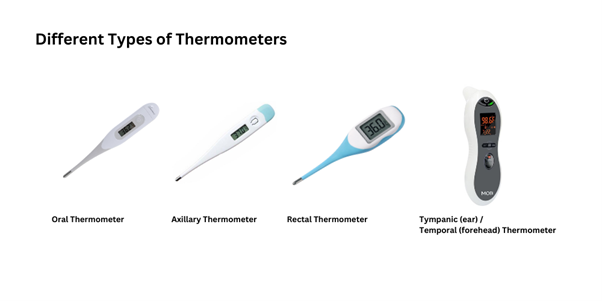What is a Thermometer?
A thermometer is a universal instrument used to measure temperature. They are generally used in various settings, including households, medical facilities, laboratories, and industrial environments, to monitor and measure temperature accurately for a wide range of applications.
One type of thermometer that we commonly use are medical thermometers or also known as clinical thermometers. They are a specialised medical device designed to measure human body temperature. Clinical thermometers are usually used by healthcare professionals to provide accurate diagnosis or used in most households to monitor and manage individuals' health conditions. For better understanding, we will explore the different types of clinical thermometers and their uses.
The Different Types of Thermometers

Handling & Instructions for Use of Clinical Thermometers
Oral Thermometers (under your tongue) - typically for adults and children who are old enough to understand how to keep the thermometer under their tongue. It is important to note that Oral thermometers should not be used if your child is shivering.
- Observe proper hygiene before handling the thermometer. Wash your hands with soap and warm water. clean the thermometer with a soft cloth or alcohol wipes before use, following the manufacturer's instructions. Check for any damage or defects. If the thermometer is damaged, do not use it.
- Turn on the thermometer if it has an on/off button. Some thermometers may activate automatically when removed from their storage case.
- Make sure you do not take anything hot or cold to eat or drink for 20 minutes before you take an oral temperature.
- Place the thermometer probe (the thin end) under your tongue, towards the back of your mouth. Ensure that the probe is touching your sublingual area, which is the area underneath your tongue.
- Close your mouth gently and avoid talking. Do not bite the thermometer or clamp down on it with your teeth. Hold the thermometer in place with your lips and keep your mouth closed until the temperature measurement is complete.
- Once the temperature has been recorded, the thermometer will emit a signal indicating that the measurement is complete. This signal can be a beep, a change in display, or a vibration, depending on the thermometer.
- Remove the thermometer from your mouth, avoid touching the probe to prevent germ from spreading.
- Take note of the temperature reading.
Axillary Thermometers (under your arm) - for adults but preferably used by children under 3 months old.
- Observe proper hygiene before handling the thermometer. Wash your hands with soap and warm water. clean the thermometer with a soft cloth or alcohol wipes before use, following the manufacturer's instructions. Check for any damage or defects. If the thermometer is damaged, do not use it.
- Turn on the thermometer if it has an on/off button. Most axillary thermometers have a power button or a sliding switch to turn them on.
- Make sure that the axilla (underarm) area is dry and free from sweat or any external factors that may affect the accuracy of the reading.
- Lift the arm on the side you wish to measure and place the thermometer probe directly in the center of the armpit against the skin. Make sure the probe is in contact with the skin and not covered by clothing.
- Hold it still and keep the arm close to the body during the measurement maintaining a gentle pressure on the thermometer to ensure it remains snugly in the armpit.
- Once the temperature has been recorded, the thermometer may beep or indicate when the reading is complete.
- Remove the thermometer from the armpit and check the displayed temperature.
- Take note of the reading or record it if necessary.
Tympanic Thermometers (in your ear) - suitable for children as they are difficult to stay still. If the thermometer is not properly positioned in the ear, the reading may not be accurate, and can be costly.
- Ensure that the tympanic thermometer is clean and in good working condition. If necessary, replace the disposable ear probe cover or lens filter to maintain hygiene (refer to the manufacturer's instructions for details).
- Hold the thermometer in your hand and make sure it is at room temperature to avoid false readings. Gently pull the earlobe up and back for adults and older children. For infants and younger children, pull the earlobe down and back to straighten the ear canal.
- Turn on the thermometer by pressing a power button or switch and select the appropriate mode for tympanic measurement (ear mode). Some thermometers may have additional features or modes, so refer to the user manual for specific instructions.
- Insert the thermometer's probe gently into the ear canal, aiming towards the eardrum. Be cautious not to push it too far to avoid discomfort or injury. Ensure a secure and comfortable fit by holding the thermometer steady and keeping a seal around the ear canal. Avoid moving or talking during the measurement process to ensure accuracy.
- Depending on the model, the thermometer may provide a reading on a display screen or through auditory cues. Once the measurement is complete, remove the thermometer from the ear canal.
- Read and interpret the displayed temperature value according to the thermometer's instructions. Note that a normal tympanic temperature is typically around 98.6°F (37°C), but it may vary slightly from person to person.
- Follow the manufacturer's instructions to clean and disinfect the thermometer after each use.
Temporal Thermometers (on your forehead) - these thermometers measure body temperature without needing direct skin contact. They are the most user-friendly thermometer option, although their accuracy can be unreliable.
- To ensure accurate readings, both you and the thermometer must be at room temperature. Remove any hats or head coverings that could potentially interfere with the measurement.
- Place the thermometer probe in the center of your forehead, midway between your eyebrow and hairline. Ensure the probe is making good contact with the skin.
- Turn on by pressing the power button. Some temporal thermometers may activate automatically upon contact with the skin.
- Maintain the thermometer in position and allow sufficient time for the reading to stabilize. Generally, this process takes a few seconds, although it is advisable to consult the specific instructions provided with your thermometer for the precise duration. While waiting, it's important to keep still and avoid any unnecessary movement.
- Once the temperature reading has stabilized, the thermometer will display the result on its screen or provide an audible signal. Take note of the temperature reading for reference or record it if necessary.
- Follow the manufacturer's instructions regarding cleaning and disinfection.
Rectal Thermometers (in your rectum) - this involves careful and hygienic handling.
- Observe proper hygiene before handling the thermometer. Wash your hands with soap and warm water. And make sure the rectal thermometer is clean and free from any debris or contaminants. If necessary, clean the thermometer with warm water and a mild soap or disinfecting solution, and rinse it thoroughly before use. Avoid using harsh chemicals or excessive water, as they can damage the device.
- Apply a water-based lubricant or petroleum jelly to the tip of the rectal thermometer. This helps the insertion more comfortably and minimises any potential friction.
- Choose a comfortable position for measuring the temperature. This could involve lying on your side with your knees pulled up towards your chest or standing and leaning forward, resting your elbows on a stable surface.
- Gently insert the lubricated tip of the rectal thermometer into the rectum. Insert about 1 inch (2.5 centimeters) into the rectum for an infant, and about 1 to 1.5 inches (2.5 to 3.8 centimeters) for a child or adult. Be cautious not to insert it too forcefully to prevent injury.
- Keep the thermometer in place until it beeps, or for at least one minute.
- Remove the thermometer and read the result.
- Disinfect the thermometer with rubbing alcohol or an alcohol-based wipe.
Bottom Line
Whether you're a healthcare professional or a concerned individual looking to monitor your loved ones' well-being, choosing the right clinical thermometer can make a significant difference in accurate temperature assessment. By understanding the options available and using them correctly, we can ensure accurate temperature measurement for better health monitoring.
MedCart stocks a large range of thermometers to suit all medical environments. We have digital, infrared, and other multifunction thermometers for quick and accurate readings. We also stock ear thermometers for taking temperatures in children and infants. Our thermometers are of the highest quality and are backed by our 100% satisfaction guarantee. Whether you need a thermometer for your home or your medical practice, MedCart has you covered.
Source
Health Direct. (n.d.) Types of Thermometers. Retrieved on June 29, 2023 from https://www.healthdirect.gov.au/types-of-thermome...













